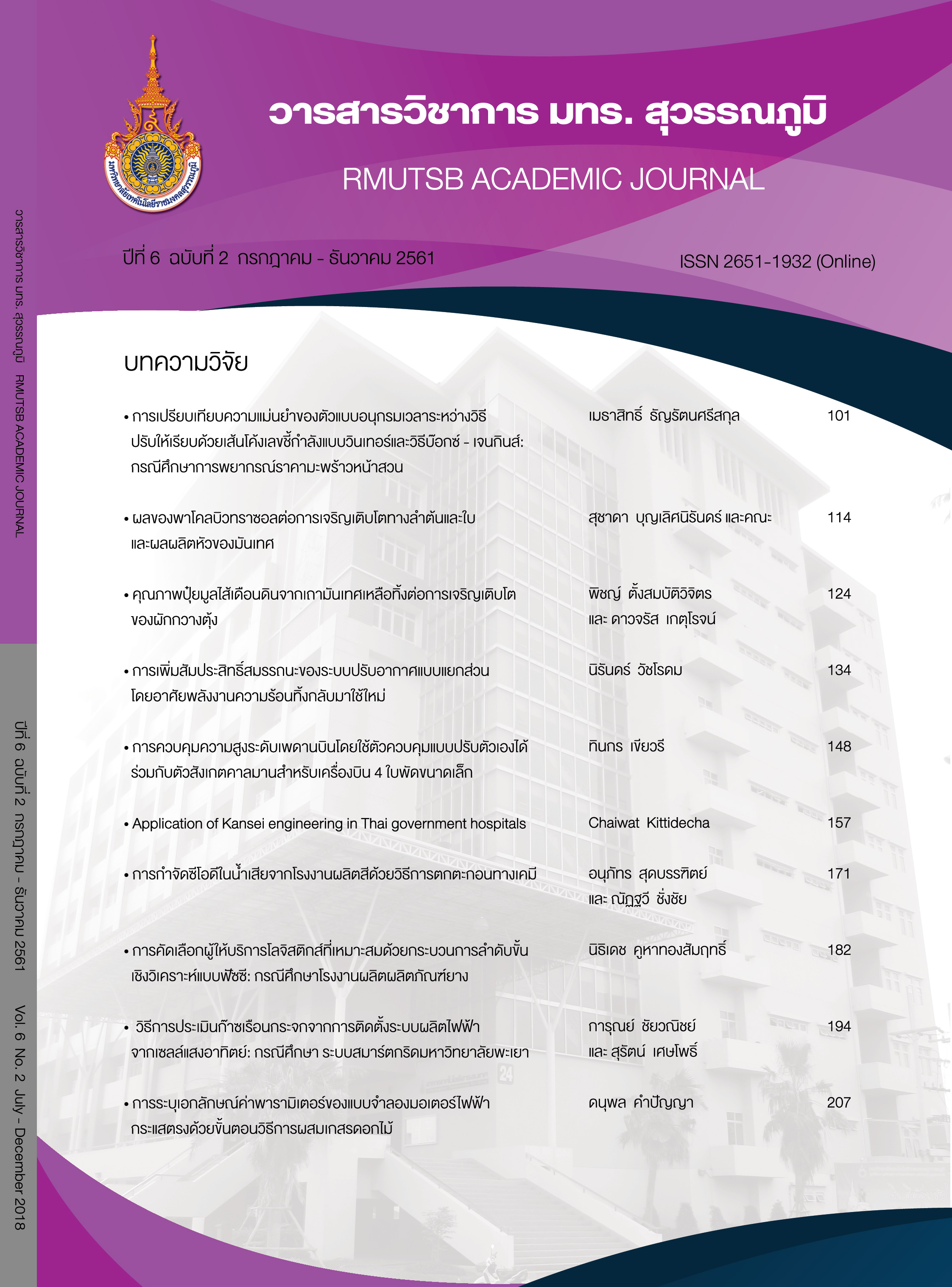Coefficient of performance increase for split-type air conditioners using heat loss recovery
Main Article Content
Abstract
This paper presented coefficient of performance (COPR) increasing for split-type air conditioner using heat loss recovery. This research aimed to study the coefficient of performance and energy saving of split-type air conditioner. In this paper, the design of a heat loss tank, which used water as heat transfer to increase temperature and pressure of refrigerant was shown. The results revealed that the temperature and pressure of refrigerant could be increased by the heat loss recovery. Therefore, the electric energy using was reduced and the coefficient of performance was improved by 50% as compared to commercial air conditioners. Furthermore, the proposed system was also appropriated for high cooling loads.
Article Details
Published manuscript are the rights of their original owners and RMUTSB Academic Journal. The manuscript content belongs to the authors' idea, it is not the opinion of the journal's committee and not the responsibility of Rajamangala University of Technology Suvarnabhumi
References
ธนะกิตติ์ ถาภัคดี. (2546). การประหยัดพลังงานในเครื่องปรับอากาศแบบแยกส่วนโดย Liquid-suction heat exchanger (วิทยานิพนธ์ปริญญามหาบัณฑิต). มหาวิทยาลัยพระจอมเกล้าธนบุรี, กรุงเทพฯ.
นิรันดร์ วัชโรดม. (2559). การออกแบบและสร้างนวัตกรรมระบบปรับอากาศประหยัดพลังงานสำหรับที่อยู่อาศัยขนาดเล็ก. ใน การประชุมวิชาการเครือข่ายพลังงานแห่งประเทศไทย ครั้งที่ 12 (E-NETT 12) (น. 1,321-1,328). กรุงเทพฯ: บริษัท ดีวีดี มาร์คเกอร์ จำกัด.
ไพบูลย์ เกียรติสุขคณาธร, กิตติพงศ์ คล้ายดี, และนภัทร วัจนเทพินทร์. (2559). การประเมินศักยภาพการคืนพลังงานไฟฟ้าสำหรับระบบขับเคลื่อนลิฟต์. วารสารวิชาการ มทร. สุวรรณภูมิ, 4(1), 11-23.
สมเกียรติ บุญณสะ. (2548). การประเมินพลังงานที่การประหยัดได้ของการนำความร้อนทิ้งกลับมาใช้ใหม่จากเครื่องอัดอากาศ. ใน การประชุมวิชาการเครือข่ายพลังงานแห่งประเทศไทย ครั้งที่ 1 (น. ECI04-1-4). ชลบุรี: เครือข่ายพลังงานแห่งประเทศไทย.
สรายุธ ทองกุลภัทร์, และพัชรนันท์ ศรีธนาอุทัยกร. (2560). การผลิตพลังงานไฟฟ้าด้วยเทอร์โมอิเล็กตริกจากเครื่องปรับอากาศ. วารสารวิชาการ มทร.สุวรรณภูมิ, 5(1), 60-67.
อัครเดช สินธุภัค. (2542). การทำความเย็น (พิมพ์ครั้งที่ 4). กรุงเทพฯ: คณะวิศวกรรมศาสตร์ สถาบันเทคโนโลยีพระจอมเกล้าเจ้าคุณทหารลาดกระบัง.
Byun, J. S., Lee, J., & Choi, J. Y. (2007). Numerical analysis of evaporation performance in a finned-tube heat exchanger. International Journal of Refrigeration, 30, 812-820.
Ha, Q. P., & Vakiloroaya, V. (2012). A novel solar-assisted air-conditioner system for energy savings with performance enhancement. Procedia Engineering, 49, 116-123.
Kiatsiriroat, T., & Euakit, T. (1997). Performance analysis of an automobile air conditioning system with R22/R124/R152a refrigerant. App. Thermal Eng., 17, 1085-1097.


